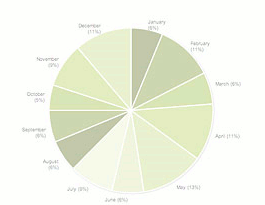


Sue V. Rosser: A Gender Gap in Patenting?
 Sue V. Rosser currently serves as Provost at San Francisco State University; from 1999-2009, she was Dean of Liberal Arts at Georgia Tech, where she held the Ivan Allen Dean's Chair of Liberal Arts and Technology and was Professor of Public Policy and of History, Technology and Society. Author of twelve books, she has also published more than 130 journal articles on women, science, technology, and health. (LH note: before Georgia Tech, Sue Rosser was at NSF and was a great leader for women's programs there.)
Sue V. Rosser currently serves as Provost at San Francisco State University; from 1999-2009, she was Dean of Liberal Arts at Georgia Tech, where she held the Ivan Allen Dean's Chair of Liberal Arts and Technology and was Professor of Public Policy and of History, Technology and Society. Author of twelve books, she has also published more than 130 journal articles on women, science, technology, and health. (LH note: before Georgia Tech, Sue Rosser was at NSF and was a great leader for women's programs there.)
Most research universities place increasing emphasis upon innovation, technology transfer and applied research. In all countries, across all sectors and in all fields, the percentage of women obtaining patents is not only less than their male counterparts but it is less than the percentage of women in science, technology, engineering, and mathematics in the field in the country.
This raises questions of what is the evidence that women aren't obtaining patents at the same rate as their male counterparts and whether this is a gender issue. For example, a 2007 study from the National Center for Women and Information Technology reported that from 1980-2005, using fractional counts, the percentage of women inventors has increased from 1.7% in 1980 to 6.1% in 2005. These data underline that 93.9% of the U.S. origin patents come from men who constitute around 70% of the U.S. IT workforce. A similar gender gap pattern found in other fields with regard to patenting appears to occur in the life sciences, where women are closer to parity. A study restricted to a sample of 4,227 life science faculty found that 5.65% of the women while 13.0% of the men held at least one patent, despite no significant differences in publication patterns.
Problems and losses result from a gender gap in patenting that results in exclusion of women. First, women who are scientists lose. Second, science experiences a loss in attracting more individuals with creative ideas. Third, society loses because of fewer products.

Buy Passport,Driver License,Age & ID Card,Visa: Website: https://realfakedocky.wordpress.com/
Buy high quality Real Passports, Visas, Driver's License ,ID CARDS, Marriage certificates, Diplomas, Birth Certificates, Credit cards, Utility bills, Social Security cards, Resident permits, Death certificates, Seaman cards, e.t.c
We are a team of highly experienced and sophisticated IT professionals with many years of experience in producing high quality documents of all categories.
We offer original high quality real and not real passports, driver driving, ID cards, stamps, birth certificates, diplomas, e.t.c for almost all countries in the world mostly countries like: US, AustrAalia, Belgium, Brazil, Norway, Canada, Italy, Finland, France, Germany, Israel, Mexico, Netherlands, South Africa, Spain, United Kingdom, e.t.c
This list is not complete.
For additional information and to place your order, just contact us by email, skype or phone.
Contact:
email: (genuinedockies201@gmail.com)
whatsapp ....+237670725929
Skype Id: lugert2
Web Site: https://realfakedocky.wordpress.com/
Do not hesitate to contact us by email or call at any time and in any
discretion.
TOPICS:
BUY REAL AND Not-Real PASSPORTS:
Buy real and Not-Real USA passports
Buy real and Not-Real Australian passports
Buy real and Not-Real Belgian passports
Buy real and Not-Real Brazilian passports
Buy real and Not-Real Canadian passports
Buy real and not real French passports
Buy real and not real New Zealand passports
Buy real and not real German passports
Buy real and not real Dutch (Netherlands) passports
Buy real and not real Israeli passports
Buy real and not real UK (United Kingdom) passports
Buy real and not real Spanish passports
Buy real and not real Mexican passports
Buy real and not real South African passports
Buy real and not real Swiss (Switzerland) passports
Buy real and not real Chinese passports
Buy real and not real Austrian passports
Buy real and not real Japanese passports
Buy real and not real Ukrainian passports
Buy real and not real Cambodian passports
Buy real and not real Romanian passports
Buy real and not real Polish passports
Buy real and not real Bulgarian passports
Buy real and not real Moroccan passports
Buy real and not real Cyprus passports
Buy real and not real Norwegian passports
Buy real and not real Portuguese passports
Buy real and not real Lithuanian passports
Buy real and not real Russian passports
Buy real and not real Hungarian passports
Buy real and not real Brazilian passports
Buy real and not real Italian passports
Buy real and not real Jamaican passports
Buy real and not real South Korean passport
Buy real and not real Croatian passports
Buy real and not real Danish passports
Buy real and not real Malta passports
Buy real and not real Swedish passports
BUY REAL AND Not Real DRIVING LICENCE
Buy real and not real USA driver's license
Buy real and not real New Zealand driver's license
Buy real and not real German driver's license
Buy real and not real Dutch (Netherlands) driver's license
Buy real and not real Israeli driver's license
Buy real and not real UK (United Kingdom) driver's license
Buy real and not real Spanish driver's license
Buy real and not real Mexican driver's license
Buy real and not real South African driver's license
Buy real and not real Swiss (Switzerland) driver's license
Buy real and not real Chinese driver's license
Buy real and not real Austrian driver's license
Buy real and not real Japanese driver's license
Buy real and not real Ukrainian driver's license
Buy real and not real Cambodian driver's license
Buy real and not real Romanian driver's license
Buy real and not real Polish driver's license
Buy real and not real Bulgarian driver's license
Buy real and not real Moroccan driver's license
Buy real and not real Cyprus driver's license
Buy real and not real Norwegian driver's license
Buy real and not real Portuguese driver's license
Buy real and not real Lithuanian driver's license
Buy real and not real Russian driver's license
Buy real and not real Hungarian driver's license
Buy real and not real Brazilian driver's license
Buy real and not real Italian driver's license
Buy real and not real Jamaican driver's license
Buy real and not real South Korean driver's license
Buy real and not real Croatian driver's license
Buy real and not real Danish driver's license
Buy real and not real Malta driver's license
Buy real and not real Swedish driver's license
contact:
email: (genuinedockies201@gmail.com)
whatsapp ....+237670725929
Skype Id: lugert2
Website:
https://realfakedocky.wordpress.com/
Do not hesitate to contact us by email or call at any time and in any
discretion.
Thanks for putting up with me. Its been a lot of years since I worked anywhere that invention was the raison d'etre of the facility.
My field seems to be in the middle of the 100 years patent war where all the players are gathering up patents to beat back their competitors. Google just played the role of stocking horse with a bid of $900 million for the patent portfolio of Nortel. Hardly, a search engine player.
http://www.sfgate.com/cgi-bin/article.cgi?f=/g/a/2011/04/06/prweb8280530.DTL
I would have thought that women would have been dragged into this fray by their employers at this point.
Anyway thanks for the post and the responses.
In terms of patents vs. publication rates, a study restricted to a sample of 4,227 life science faculty found that 5.65% of the women while 13% of the men held at least one patent, despite no significant differences in publication patterns (Thursby and Thursby, 2005). The lower percentage of women obtaining patents appears to hold across sectors of government, academia, and industry (Stephan and El-Ganainy, 2007), with the exception of science-based network firms in the biotechnology industry (Bunker Whittington and Smith-Doerr, 2008) where women are equally as likely as men to become involved in initial phases of patenting but do not patent as frequently as men.
The citation that Laura gave for the Frietsch article is correct, as is her interpretation of the fractional count. The following is an example of how this works out when comparing patents on which there is at least one female inventor to fractional accounts:
A 2007 study from the National Center for Women and Information Technology (NCWIT) reported that from 1980-2005, approximately 9% of U.S.-invented information technology (IT) patents had at least one female inventor (Ashcraft and Breitzman, 2007). Others use fractional counts. When the fraction of the patent that can be counted as female is calculated, the overall percentage of female U.S.-invented patents drops to 4.7%, although the fractional percentage has increased from 1.7% in 1980 to 6.1% in 2005.
Hi Melissa and Alan,
I believe that the authors used a method that did take into account all the names on the patent applications. Here is a brief extract from their methods:
"The calculation involves several steps. First, the share of women/men per team is computed assuming a uniform contribu-tion: for example, if five inventors (including two women) together apply for a patent, each of them is assumed to contribute 1/5th, and the share of women then is 2/5th. Second, the sum of these shares over all patent applications (or publications), differentiated by sex, is calculated. Finally, this sum is divided by the total number of patent applications (or publications) in the sample. To put it in other words, the contribution of men and women is calculated on the basis of ‘fractional counts’ of co-inventors (or co-authors)."
So they believe it's a fair way to count how much women contributed to patenting whether or not they were the first contributor on the patent.
cheers,
Laura
Hi Scifeminista,
I worked at Bell Labs (that will tell you something about my age) and I will guarantee that anything that had the potential to be patented was patented. The choice was the company's not the researchers. I don't think that has changed; in fact it is probably more intense now than in the past.
I imagine that a research University would also push patentable research to the patent office, regardless of the gender of the researcher. (swag)
I am inclined to think the answer might be a little more insidious.
1. The patents are issued to the head of the research department, with no acknowledgement of his staff.
2. The Frietsch report only looked at the first name on the patent application.
I could not find out from the report if they accounted for multiple applicants. Although they did concede that they were unable to determine the gender of some applicants.
Melissa this is the link I think
http://genet.csic.es/biblioteca/Frietsch%20Gender%20patterns%20in.pdf
I would say that Alan Cohen would like to get the reference to Frietsch that Sue Rosser referred to above and read more about this subject, and so would I. Laura, could you try to get this reference, the details of it, for us?
MKS
To Alan Cohen: A third possibility is that they are working in fields where THEY don't feel like part of the culture, rather than patenting not being a part of it. That possibility is probably more visible to women than to men.
I am interested that patents are evidently an area that does NOT match women's production of scientific articles. I would think both would tap into those insecurities Laura highlighted with her poll, so it's a surprise that they don't look the same numerically. It sounds like the women feel the stakes for claiming a patent are HIGHER than for writing a paper. I'm not sure why this should be true.
Thank you for the quick response;
This question may be skewed by Dr. Hoopes' choice of responses to the article.
Is the issue or question, that women as a group are creating things that could be patentable, but are choosing not to? And then the idea is re-invented and patented by a male. Or enter the public domain.
Or are they working in fields where patents just are not part of the culture. As an EE I find that one hard to understand.
Or are they working in fields that are established/legacy and unlikely to come up with much new.
Yes, it's true that women engineers patent at lower rates, relative to their percentages in the subfield, than their male counterparts. In fact, international studies document that in all countries in all different areas, the percentage of women obtaining patents is significantly lower than that of the male counterparts. Considerable variation exits among the technological fields, with pharmaceutical (24.1%) and basic chemicals (12.5%) tending to have higher percentages of patents obtained by women, and machine-tools (2.3%) and energy machinery (1.9%) having lower percentages (Frietsch et al. 2007).
Considerable difference in the percentage of women obtaining patents occur among countries. The study of patenting in fourteen countries by Frietsch documented that, in general, the percentage of women's patenting has increased during the past decade in all countries, but the percentage of women obtaining patents in each country is less than the percentage of women in the STEM workforce.
Hi Laura,
I would like to see the numbers for engineers. I would think that as a group they would be the group most likely to come up with patents. The sciences and math seem to be limited in the patent field; great discoveries are possible but not patentable.
Also, does the survey take into account, women working at research labs where they might be co-inventors. I am really having cognitive problems with believing that good ideas are just going straight into the public domain.
Thanks,
Alan
Hi Alan,
Yes, that's true. But even in fields where women COULD patent their work, often they don't. Sue Rosser has data showing that, but in this short piece she didn't have room to include it.
Sorry about the poll, it's my fault, not Sue's. It needed a "none of the above" button, at the very least!
cheers,
Laura
How many women are working in areas where patents are even possible?
Not every discovery is patentable. Only the creation of something new ( U.S. Supreme Court and DNA being the insane exception) can be patented.
The questions answers are inadequate. Why don't astronomers have patents; gee whiz professor maybe its because while they discover all sorts of things they did'nt invent them.
Hi Laura,
You should have had an option to choose all three! I think they all play into the lack of women, myself. But the teamwork one probably is covered by the fact that you can patent with the whole team.

















